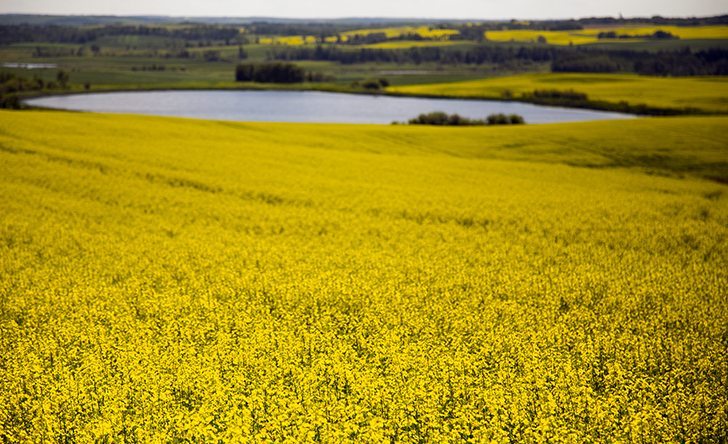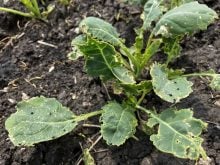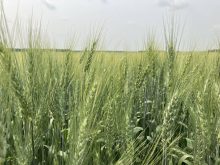Studies have found canola increases soil organic carbon, resulting in a reduction in greenhouse gas emissions
The recent Paris climate accord will likely increase world attention on the carbon footprint associated with crops.
This could be good news for Canadian canola producers, who produce lower amounts of greenhouse gas than producers in other canola and rapeseed regions.
“Canola is unique in terms of the amount of soil organic carbon (SOC) that it puts into the soils, and increasing the amount of SOC in the soils benefits crops,” Agriculture Canada researcher Brian McConkey told a recent canola industry meeting in Saskatoon.
“It’s all kind of a nice story. Canola is good for carbon and carbon is good for canola, from a production level as well as from marketing.”
Read Also

Farming Smarter receives financial boost from Alberta government for potato research
Farming Smarter near Lethbridge got a boost to its research equipment, thanks to the Alberta government’s increase in funding for research associations.
Studies have found that soil organic carbon decreases rapidly when forest and grassland are converted to cropland but then stabilizes as pastures and cropland become established.
However, studies have also found that soil organic carbon increased in prairie soil when producers moved to zero tillage, reduced summer fallow acreage and rotated between annual and perennial crops.
Soil organic carbon levels have been rising in many parts of the Prairies by 35 kilograms per acre per year, which is significant when taking the size of the region into consideration, said McConkey.
The increase in soil organic carbon accounts for 11 million tonnes of carbon dioxide per year in Canda, which reduces Canada’s net greenhouse gas emissions by 1.5 percent.
The benefit is reduced to 7.4 million tonnes of CO2 when the carbon emitted from the creation of new cropland is considered, which brings Canada’s net greenhouse gas emissions down only one percent.
He said a comparison of canola production in Germany and the Prairies found fewer emissions on the Prairies.
“Fifteen, 20, 25 percent of emissions are reduced in the carbon footprint because of taking CO2 out of the atmosphere,” McConkey said.
Some prairie regions, such as the Red River Valley in Manitoba, are not increasing soil organic carbon as much as other regions.
However, growing canola in Canada generally produces less net carbon emissions than in Germany, which gives Canadian canola a better value when selling into Europe.
“(It) gives us a competitive advantage,” he said.
“It’s also becoming more important in the American market. Millions of tonnes of canola could potentially be sold into the California market for vegetable oils for biodiesel.”
California ranked Canadian canola as the lowest emission among oilseeds, McConkey said.
“Those jurisdictions with cap and trade systems are desperate for immediate GHG reductions and biodiesel from Canadian canola can provide that.”
Biodiesel may become a big future market for canola as economies shift away from fuel with greater net carbon emissions.
A fuel’s life cycle greenhouse gas emission is calculated as the total greenhouse gas emissions related to the fuel’s life cycle, including all stages of fuel and feedstock production and distribution. It is the net value for all greenhouse gases adjusted to account for their climate change potential, which includes how much carbon the feedstock crop fixes into the soil.
Biodiesel’s life cycle greenhouse gas emission level varies according to crop used, which is where canola has a competitive advantage over other feedstocks.
Canola and rapeseed consistently rank as the best biofuel feedstock when calculating net carbon emissions.
The Renewable Fuel Standard Program in the United States requires biofuel to achieve a 50 percent reduction in greenhouse gas emissions to meet the biomass-based diesel requirements, compared to 25 percent in Alberta and 35 percent in the EU, although that is expected to increase to 50 percent by 2018.
Sustainable grower programs also consider carbon emissions, especially in Europe but also in the U.S., where buyers find sustainable growers so that they can sell into those markets.
These programs audit growers to assess their sustainability, including the amount of greenhouse gas emissions that their farming practices produce.
The results are calculated with the average soil carbon gain rather than crop specific values. The reporting units (RU) are related to ecological zones, which in turn are related to soil zones.
“The canola buyer tracks the location where canola was grown,” McConkey said.
“The canola buyer then provides a mass-weighted carbon footprint for the canola shipment based on RU where it was sourced. The value in Europe increases as carbon footprint value decreases.”
Greenhouse gas emissions produced from canola production vary across the Prairies because of soil types, climate differences, production practices and the types and amounts of nitrogen fertilizer used.
However, canola production in all regions adds a lot of carbon into the soil, one and a half times more than wheat.
This may be counterintuitive for some people, especially when a comparison of wheat and canola stubble appears to show far more residue on the wheat field.
“If you get down to the details of the canola residue, many of the leaves are decomposed by harvest, and the pods are pulverized by harvest operations, so there just doesn’t appear to be as much carbon,” McConkey said.
Canola adds about 35 kg per acre in Saskatchewan, he added.
Increasing soil organic carbon also has significant agronomic benefits, such as an improvement in soil structure and fertility.


















